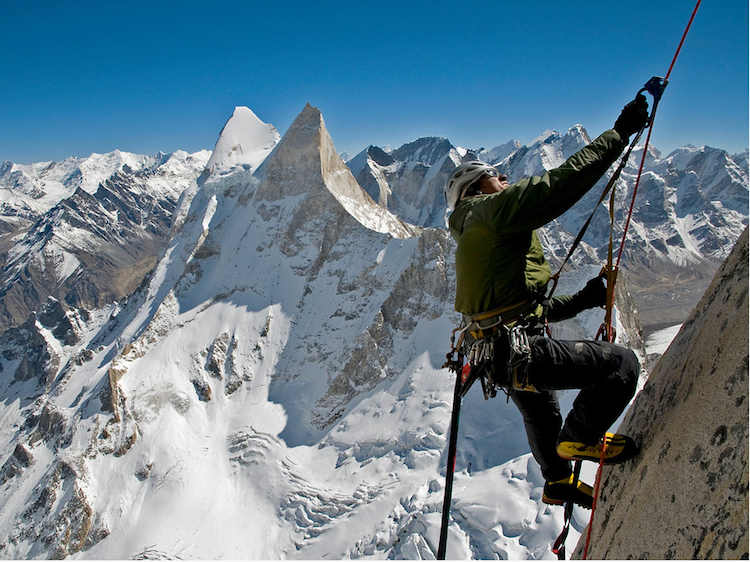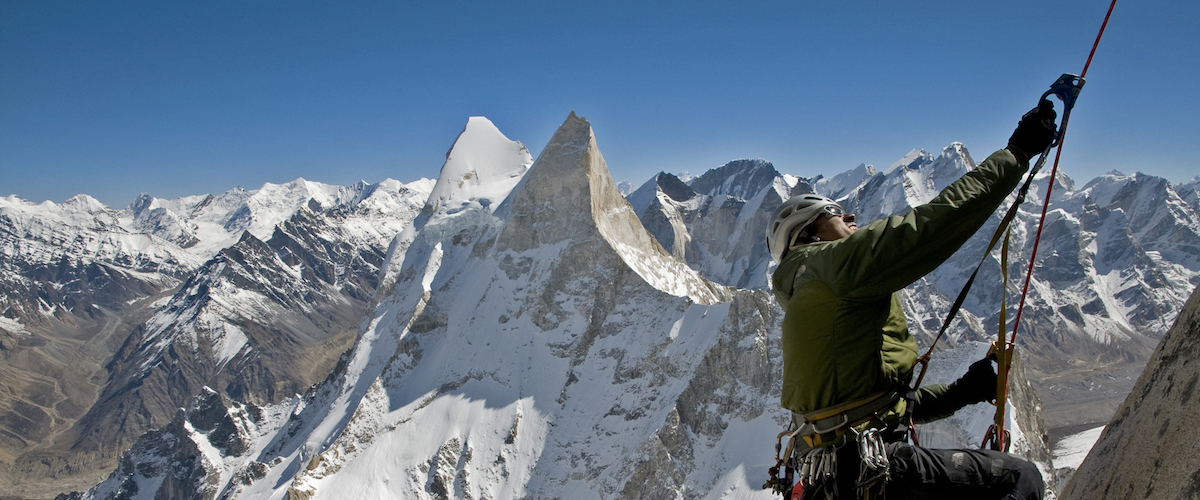Renan Ozturk captures stories at the edge of the human condition. “I want to show humanity on the fringes,” says the photographer and documentary filmmaker. “Whether that’s high in the mountains or isolated on the edge of the earth, these cultures need their voices amplified in some way.”

Renan Ozturk
A world-class climber, Ozturk is best known for his work as the director of photography and high-altitude director on the award-winning documentary Sherpa—which explores the Sherpa people’s cultural connection to Mount Everest—and for the Sundance Audience Award–winning Meru, which recounts the near-death accidents and transcendent beauty of Ozturk’s attempts, with climbers Conrad Anker and Jimmy Chin, to climb the most-tried-and-failed peak in the Himalaya range.
In addition to being a prolific documentary filmmaker, Ozturk is a photojournalist for National Geographic and Sony, an expedition climber for The North Face, a co-owner of the production company Camp4 Collective, and a commercial director for clients including Apple, Nike, Yeti, ESPN, and NBC. On top of all that, he’s also a talented landscape painter.
Driven to show our connection to the natural world, the soft-spoken Ozturk faces extreme challenges: physical, cultural, and technological. He dangles thousands of feet in the air while shooting, hauls gear through the planet’s most extreme environments, flies ultra-light experimental aircraft to capture aerial shots, pilots drones during technical ascents of the earth’s most challenging peaks, and spends months slowly getting to know the people who live in the world’s most remote locations.
“To be ‘in the right place at the right time,’ in an incredibly intimate situation, you have to work with people for months and have trust building, and approach the photography in that way,” he says. “I build relationships for months or years. You have to go in very slowly and carefully, respectfully, and show a lot of reciprocity—include them in the storytelling process as much as possible, ask their ideas, shoot for them, learn from them, give them photos, always carry a Polaroid, always bring gifts. It’s a long process.”
Ozturk’s favorite projects combine astounding images of nature with a compelling human element, such as a recent National Geographic feature, “The Last Death-Defying Honey Hunter of Nepal.” The magazine article and accompanying behind-the-scenes video documented a waning tradition of the Kulung culture in Nepal: Kulung men venture hundreds of feet up sheer cliffs on bamboo rope ladders to gather psychotropic honey from the world’s largest bees.
Ozturk was the photographer for a National Geographic feature titled “The Last Death-Defying Honey Hunter of Nepal,” which documented the dying Kulung tradition of harvesting wild honey from cliffs in Nepal. Ozturk filmed a behind-the-scenes video while on location with the Kulung people—about which he writes, “Don’t think we will ever top this film premiere. Heart-melting moment sharing the film with village of Saadi where it took place.”
“That was a good example of high-angle shooting on ropes,” says Ozturk, “trying to capture one of the last remaining honey hunters in this village of a shamanistic culture that may not be around forever, basically documenting the last harvest. Stories like that drive me.”
BIG PICTURE, SMALL PACKAGE
Ozturk says his biggest technical challenge is figuring out how to get the highest-quality images with the smallest packages. “I only got into this because the cameras started getting smaller and you could actually take them on these climbs without feeling like you were going to die trying to carry them,” he says.
His time-tested workhorse is a Sony a7 Full Frame Mirrorless camera with a 24–70mm f4 lens and a couple of filters. “It’s half the size and weight of cameras just a few years older,” he says. “When you are truly at the ends of the earth, if you can just simplify to a single a7 and a few lenses, you can bring back something really powerful and still be moving through these environments in ways you couldn’t just five years ago.”
On a difficult expedition to the most remote part of the Burmese Himalaya, Ozturk’s team lost food and clothing, and endured grueling setbacks, harsh conditions, and bitter disappointments.
“I think the best example is this trip we did for National Geographic and The North Face to the Burmese Himalaya,” he continues, “where we were trying to figure out what the highest point in Southeast Asia was. The only way to do that is to climb these mountains with a sophisticated GPS. It was a really hard trip, one of the most remote places in the Himalaya you can travel to. We ran out of food, and we had to leave a lot of our warm clothing behind with the bigger camera gear. But the first-generation a7S lasted the entire trip from the jungle all the way up to 19,000 feet on the border of Tibet and Burma. It brought back stills that were double-page spreads in the magazine and an entire National Geographic hour-long TV special in that tiny little package. That was the first-generation a7S, and it’s only gotten better from there.”

To capture aerial shots, Ozturk uses drones, small propeller planes, or ultra-light experimental aircraft, mounting cameras on gimbal systems.
Another game-changer is the advent of drone technology. Ozturk says he loves using drones—he uses everything from a Freefly Alta to smaller DJI drones, often hiking and flying the drone at the same time. “It’s a more efficient way to capture shots,” he says. “Normally I’m not climbing as the drone is flying, unless I’m at a belay and we’re stopped. But when you’re hiking, you can fly the drone as you’re moving. You’re holding a small controller, checking in on it, or you just put a drone in the air and have it sit there, like a locked-off shot, and then shoot with other cameras and land it after the action is complete.”
A CREATIVE JOURNEY
Ozturk’s first love wasn’t photography; it was landscape painting. Born in Germany, he grew up in Rhode Island and got a biology degree from Colorado College. “After I graduated, I gave away all my stuff and went on the road as a climber and artist. I lived for about four years in climbing areas and national parks across the desert southwest, spending summers up through British Columbia. It was a really simple lifestyle, that’s what it takes to learn how to climb and move in the mountains, and learn different styles of rock,” he says. “I would climb and do artwork, and eventually that led to sponsorships. I started to do big international expeditions with The North Face, and through that the filmmaking started.”
When he can, Ozturk paints while on expedition, carrying large swaths of raw cotton canvas and using mixed media and sometimes natural pigments on site. “Now I’ve got four different films going at the same time, so I don’t paint as much,” he says. “But it’s still something that I actively try to bring back, whenever I can.” You can check out his paintings on his portfolio site.
Entirely self-taught, Ozturk parlayed his climbing films into more commercial work, documentaries, time-lapse photography, and National Geographic expeditions. He edits most of his films himself, using Adobe Premiere Pro CC. “I really like being able to edit footage in its full-resolution raw form,” he says. “A lot of the high-resolution time lapses that I’ve been shooting, you’ve got 8K video playing back natively. I use Warp Stabilizer to smooth out motion-controlled time-lapses or hand-held footage from boats or airplanes. And if it’s a short turnaround, I’ll just do my own color work with the Lumetri Color panel.”
Ozturk says his subject matter has evolved over time. “There’s a snowballing effect in terms of the stories you realize you can tell,” he says. “The beauty of the landscapes drove me initially, and the love for climbing as a community and the places that it can bring you. When you start doing these bigger expeditions, you interact with these cultures in Nepal or Pakistan or deep in the jungle. That made me want to shift my focus to telling stories that are more culturally focused, as well as contribute to positive change in the planet.”
Ozturk’s landscape photography often has a painterly feel, as in this image of the Himalaya at sunrise.
This winter, Ozturk is back home in Park City, Utah, where he lives in a unique passive solar home with his wife and creative partner, Taylor Rees, and their husky-wolf-mix “dog-child.” He’s spending much of his time training for an upcoming Everest expedition for National Geographic. “It’s sort of a regimented plan that involves a lot of Zone 2 heart-rate cardio, so that your heart is stronger and assimilating oxygen better,” he explains. “You do a lot of the workouts fasted, so your body learns to burn fat, because when you’re up at high altitude you’re usually too nauseous to eat.”

Time-lapse images, frequently of starry skies, are a favorite of Ozturk’s.
He’s currently wrapping up several projects, including a documentary with director Sanjay Rawal about Native American food sovereignty, called Gather, and a passion project on climbing legend Brad Washburn, called Sanctity of Space. He and Rees are starting work on a feature about the impact of lithium mining on indigenous cultures in the Atacama Desert of South America. “And I’ve been doing a personal project on the Bear’s Ears, because I cut my teeth climbing in this Moab desert sandstone, and I want to spend more time back in these places where I grew up, and helping with the fight that’s going on,” he says.
“I’ve spent a lot of time out of country,” says Ozturk. “But it’s been awesome this year to realize how many important stories are actually close to home.”
See more of Ozturk’s documentary and photography work on his website.
February 1, 2019





